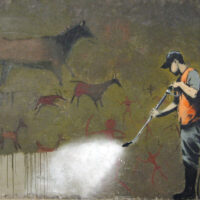FREE open access journal article by myself, Diāna Bērziņa, and Aaron Wright
[Image by Banksey]
Available in The Professional Geographer: https://www.tandfonline.com/doi/full/10.1080/00330124.2021.1957690
The majority of the ancient rock art sites of the U.S. Southwest are located in rural locations that are difficult to monitor or police. These sites seem to exert a pull on humans, an attraction that not only provokes curiosity and wonder but also what can be classed as destructive responses or vandalism. Many crime control methods for reducing vandalism are based on traditional theories such as defensible space and broken window theory. In the case of rock art, however, these methods do not yield expected results and in some cases are even detrimental. Rural crime, including rural vandalism, as a whole is marginalized in criminology, which has been dominated by urban-focused approaches and theories. In the case of rock art, considering how security is approached and maintained ultimately leads to questions about human–object relationships with regards to crime and about object agency. By focusing on the policing challenges of one particular type of rural vandalism, we hope to contribute to the discussion of vandalism in rural spaces.
